The Impact of Environmental Regimes on Global Environmental Governance
VerifiedAdded on 2023/03/17
|29
|7838
|47
Report
AI Summary
This report examines the impact of environmental regimes on Global Environmental Governance (GEG). It begins with an introduction outlining the background, research aims, objectives, questions, and problem. The literature review explores environmental regimes and their impact on GEG, discussing issues faced by GEG in adhering to these regimes. The methodology section details the research philosophy, approach, design, data collection methods, timeframe, and data reliability, concluding with estimated findings. The report aims to assess the need for regimes, examine their relationship with GEG, identify issues faced by environmental agencies, and suggest recommendations. The study emphasizes the importance of environmental regimes in shaping organizational operations and promoting sustainability, while also acknowledging challenges like lack of collaboration and high costs. The report utilizes existing literature to support its arguments and proposes future research directions. The report also highlights the role of various international agreements and conferences in establishing environmental regimes and their influence on environmental governance.
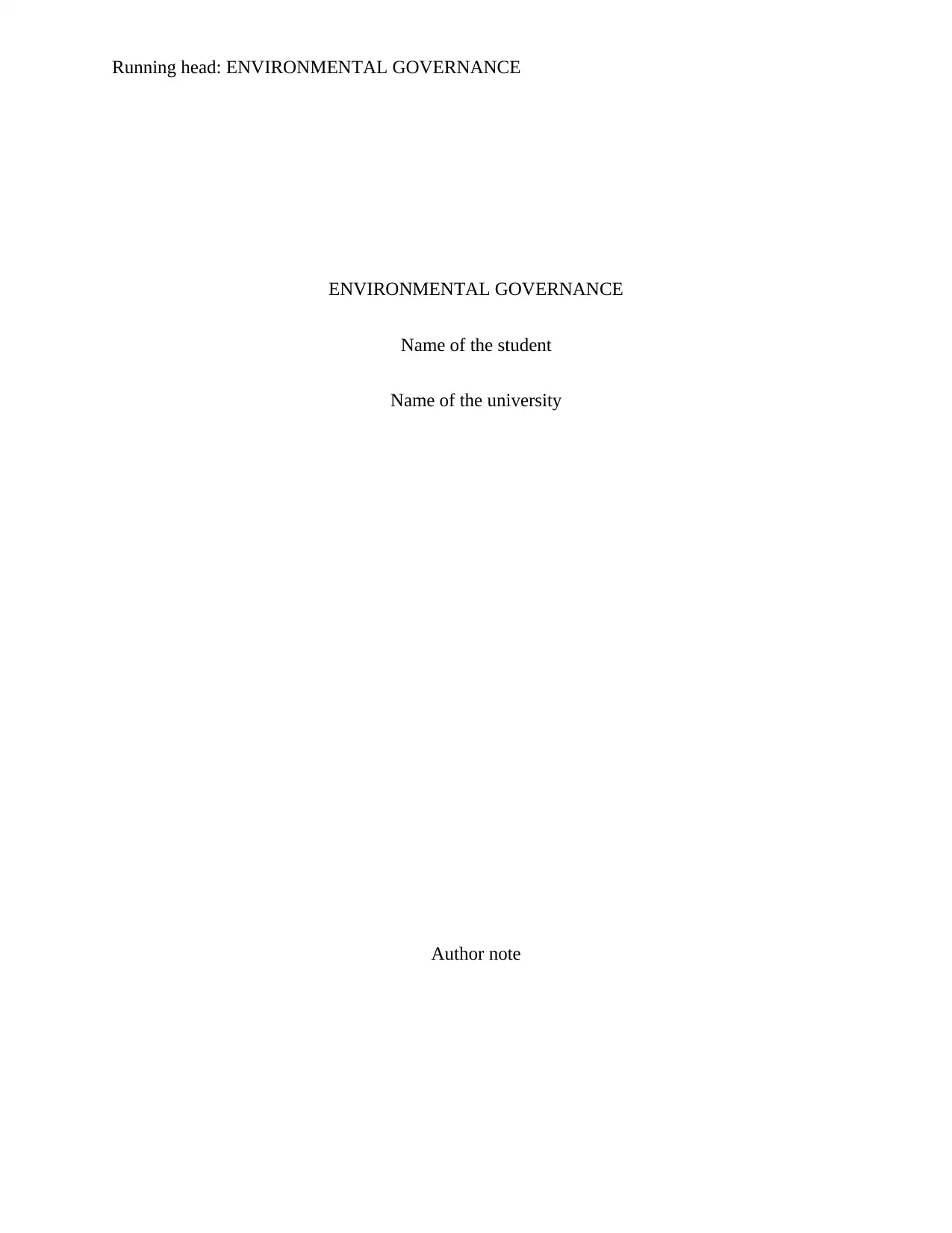
Running head: ENVIRONMENTAL GOVERNANCE
ENVIRONMENTAL GOVERNANCE
Name of the student
Name of the university
Author note
ENVIRONMENTAL GOVERNANCE
Name of the student
Name of the university
Author note
Paraphrase This Document
Need a fresh take? Get an instant paraphrase of this document with our AI Paraphraser
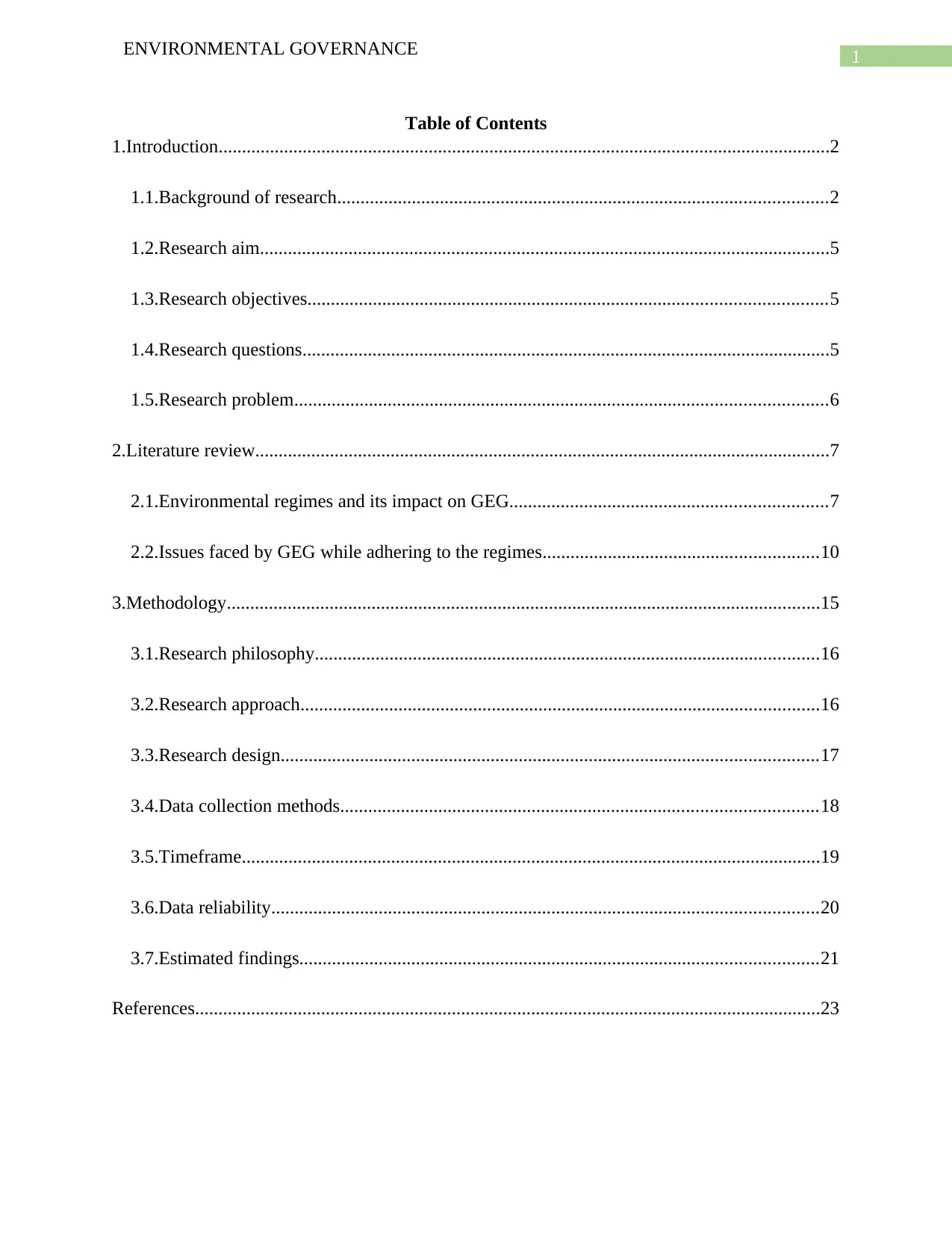
1ENVIRONMENTAL GOVERNANCE
Table of Contents
1.Introduction...................................................................................................................................2
1.1.Background of research.........................................................................................................2
1.2.Research aim..........................................................................................................................5
1.3.Research objectives...............................................................................................................5
1.4.Research questions.................................................................................................................5
1.5.Research problem..................................................................................................................6
2.Literature review...........................................................................................................................7
2.1.Environmental regimes and its impact on GEG....................................................................7
2.2.Issues faced by GEG while adhering to the regimes...........................................................10
3.Methodology...............................................................................................................................15
3.1.Research philosophy............................................................................................................16
3.2.Research approach...............................................................................................................16
3.3.Research design...................................................................................................................17
3.4.Data collection methods......................................................................................................18
3.5.Timeframe............................................................................................................................19
3.6.Data reliability.....................................................................................................................20
3.7.Estimated findings...............................................................................................................21
References......................................................................................................................................23
Table of Contents
1.Introduction...................................................................................................................................2
1.1.Background of research.........................................................................................................2
1.2.Research aim..........................................................................................................................5
1.3.Research objectives...............................................................................................................5
1.4.Research questions.................................................................................................................5
1.5.Research problem..................................................................................................................6
2.Literature review...........................................................................................................................7
2.1.Environmental regimes and its impact on GEG....................................................................7
2.2.Issues faced by GEG while adhering to the regimes...........................................................10
3.Methodology...............................................................................................................................15
3.1.Research philosophy............................................................................................................16
3.2.Research approach...............................................................................................................16
3.3.Research design...................................................................................................................17
3.4.Data collection methods......................................................................................................18
3.5.Timeframe............................................................................................................................19
3.6.Data reliability.....................................................................................................................20
3.7.Estimated findings...............................................................................................................21
References......................................................................................................................................23
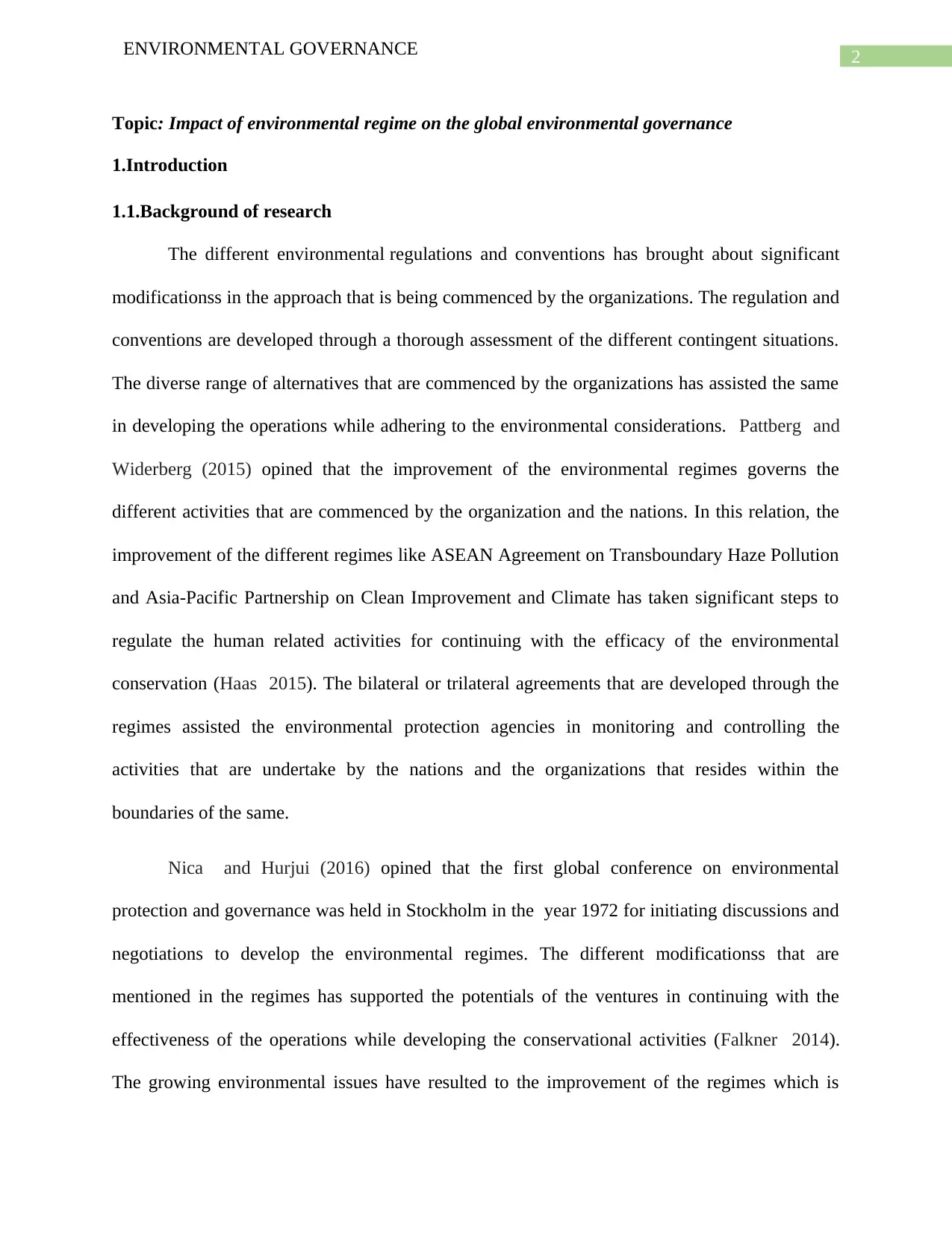
2ENVIRONMENTAL GOVERNANCE
Topic: Impact of environmental regime on the global environmental governance
1.Introduction
1.1.Background of research
The different environmental regulations and conventions has brought about significant
modificationss in the approach that is being commenced by the organizations. The regulation and
conventions are developed through a thorough assessment of the different contingent situations.
The diverse range of alternatives that are commenced by the organizations has assisted the same
in developing the operations while adhering to the environmental considerations. Pattberg and
Widerberg (2015) opined that the improvement of the environmental regimes governs the
different activities that are commenced by the organization and the nations. In this relation, the
improvement of the different regimes like ASEAN Agreement on Transboundary Haze Pollution
and Asia-Pacific Partnership on Clean Improvement and Climate has taken significant steps to
regulate the human related activities for continuing with the efficacy of the environmental
conservation (Haas 2015). The bilateral or trilateral agreements that are developed through the
regimes assisted the environmental protection agencies in monitoring and controlling the
activities that are undertake by the nations and the organizations that resides within the
boundaries of the same.
Nica and Hurjui (2016) opined that the first global conference on environmental
protection and governance was held in Stockholm in the year 1972 for initiating discussions and
negotiations to develop the environmental regimes. The different modificationss that are
mentioned in the regimes has supported the potentials of the ventures in continuing with the
effectiveness of the operations while developing the conservational activities (Falkner 2014).
The growing environmental issues have resulted to the improvement of the regimes which is
Topic: Impact of environmental regime on the global environmental governance
1.Introduction
1.1.Background of research
The different environmental regulations and conventions has brought about significant
modificationss in the approach that is being commenced by the organizations. The regulation and
conventions are developed through a thorough assessment of the different contingent situations.
The diverse range of alternatives that are commenced by the organizations has assisted the same
in developing the operations while adhering to the environmental considerations. Pattberg and
Widerberg (2015) opined that the improvement of the environmental regimes governs the
different activities that are commenced by the organization and the nations. In this relation, the
improvement of the different regimes like ASEAN Agreement on Transboundary Haze Pollution
and Asia-Pacific Partnership on Clean Improvement and Climate has taken significant steps to
regulate the human related activities for continuing with the efficacy of the environmental
conservation (Haas 2015). The bilateral or trilateral agreements that are developed through the
regimes assisted the environmental protection agencies in monitoring and controlling the
activities that are undertake by the nations and the organizations that resides within the
boundaries of the same.
Nica and Hurjui (2016) opined that the first global conference on environmental
protection and governance was held in Stockholm in the year 1972 for initiating discussions and
negotiations to develop the environmental regimes. The different modificationss that are
mentioned in the regimes has supported the potentials of the ventures in continuing with the
effectiveness of the operations while developing the conservational activities (Falkner 2014).
The growing environmental issues have resulted to the improvement of the regimes which is
⊘ This is a preview!⊘
Do you want full access?
Subscribe today to unlock all pages.

Trusted by 1+ million students worldwide
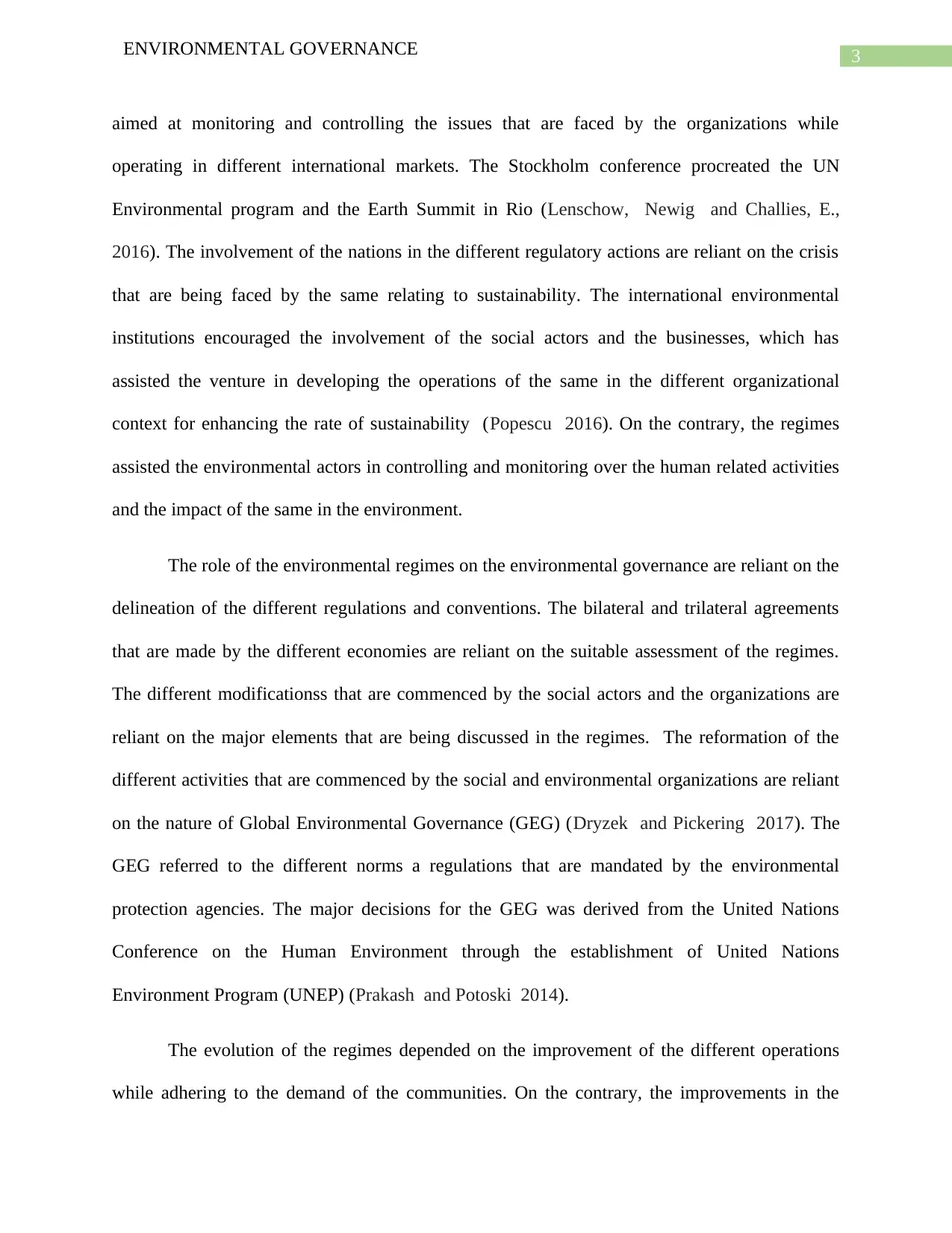
3ENVIRONMENTAL GOVERNANCE
aimed at monitoring and controlling the issues that are faced by the organizations while
operating in different international markets. The Stockholm conference procreated the UN
Environmental program and the Earth Summit in Rio (Lenschow, Newig and Challies, E.,
2016). The involvement of the nations in the different regulatory actions are reliant on the crisis
that are being faced by the same relating to sustainability. The international environmental
institutions encouraged the involvement of the social actors and the businesses, which has
assisted the venture in developing the operations of the same in the different organizational
context for enhancing the rate of sustainability (Popescu 2016). On the contrary, the regimes
assisted the environmental actors in controlling and monitoring over the human related activities
and the impact of the same in the environment.
The role of the environmental regimes on the environmental governance are reliant on the
delineation of the different regulations and conventions. The bilateral and trilateral agreements
that are made by the different economies are reliant on the suitable assessment of the regimes.
The different modificationss that are commenced by the social actors and the organizations are
reliant on the major elements that are being discussed in the regimes. The reformation of the
different activities that are commenced by the social and environmental organizations are reliant
on the nature of Global Environmental Governance (GEG) (Dryzek and Pickering 2017). The
GEG referred to the different norms a regulations that are mandated by the environmental
protection agencies. The major decisions for the GEG was derived from the United Nations
Conference on the Human Environment through the establishment of United Nations
Environment Program (UNEP) (Prakash and Potoski 2014).
The evolution of the regimes depended on the improvement of the different operations
while adhering to the demand of the communities. On the contrary, the improvements in the
aimed at monitoring and controlling the issues that are faced by the organizations while
operating in different international markets. The Stockholm conference procreated the UN
Environmental program and the Earth Summit in Rio (Lenschow, Newig and Challies, E.,
2016). The involvement of the nations in the different regulatory actions are reliant on the crisis
that are being faced by the same relating to sustainability. The international environmental
institutions encouraged the involvement of the social actors and the businesses, which has
assisted the venture in developing the operations of the same in the different organizational
context for enhancing the rate of sustainability (Popescu 2016). On the contrary, the regimes
assisted the environmental actors in controlling and monitoring over the human related activities
and the impact of the same in the environment.
The role of the environmental regimes on the environmental governance are reliant on the
delineation of the different regulations and conventions. The bilateral and trilateral agreements
that are made by the different economies are reliant on the suitable assessment of the regimes.
The different modificationss that are commenced by the social actors and the organizations are
reliant on the major elements that are being discussed in the regimes. The reformation of the
different activities that are commenced by the social and environmental organizations are reliant
on the nature of Global Environmental Governance (GEG) (Dryzek and Pickering 2017). The
GEG referred to the different norms a regulations that are mandated by the environmental
protection agencies. The major decisions for the GEG was derived from the United Nations
Conference on the Human Environment through the establishment of United Nations
Environment Program (UNEP) (Prakash and Potoski 2014).
The evolution of the regimes depended on the improvement of the different operations
while adhering to the demand of the communities. On the contrary, the improvements in the
Paraphrase This Document
Need a fresh take? Get an instant paraphrase of this document with our AI Paraphraser
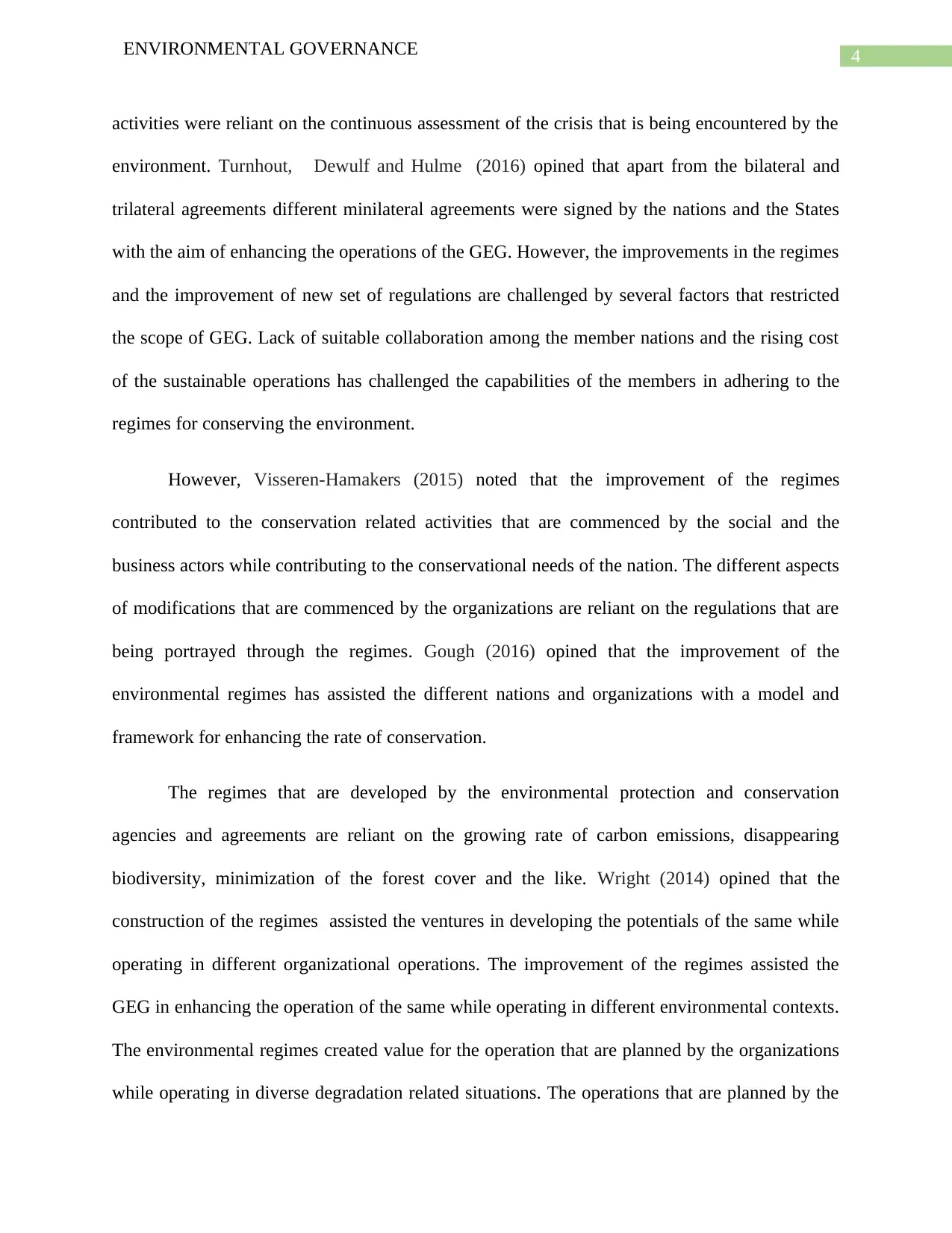
4ENVIRONMENTAL GOVERNANCE
activities were reliant on the continuous assessment of the crisis that is being encountered by the
environment. Turnhout, Dewulf and Hulme (2016) opined that apart from the bilateral and
trilateral agreements different minilateral agreements were signed by the nations and the States
with the aim of enhancing the operations of the GEG. However, the improvements in the regimes
and the improvement of new set of regulations are challenged by several factors that restricted
the scope of GEG. Lack of suitable collaboration among the member nations and the rising cost
of the sustainable operations has challenged the capabilities of the members in adhering to the
regimes for conserving the environment.
However, Visseren-Hamakers (2015) noted that the improvement of the regimes
contributed to the conservation related activities that are commenced by the social and the
business actors while contributing to the conservational needs of the nation. The different aspects
of modifications that are commenced by the organizations are reliant on the regulations that are
being portrayed through the regimes. Gough (2016) opined that the improvement of the
environmental regimes has assisted the different nations and organizations with a model and
framework for enhancing the rate of conservation.
The regimes that are developed by the environmental protection and conservation
agencies and agreements are reliant on the growing rate of carbon emissions, disappearing
biodiversity, minimization of the forest cover and the like. Wright (2014) opined that the
construction of the regimes assisted the ventures in developing the potentials of the same while
operating in different organizational operations. The improvement of the regimes assisted the
GEG in enhancing the operation of the same while operating in different environmental contexts.
The environmental regimes created value for the operation that are planned by the organizations
while operating in diverse degradation related situations. The operations that are planned by the
activities were reliant on the continuous assessment of the crisis that is being encountered by the
environment. Turnhout, Dewulf and Hulme (2016) opined that apart from the bilateral and
trilateral agreements different minilateral agreements were signed by the nations and the States
with the aim of enhancing the operations of the GEG. However, the improvements in the regimes
and the improvement of new set of regulations are challenged by several factors that restricted
the scope of GEG. Lack of suitable collaboration among the member nations and the rising cost
of the sustainable operations has challenged the capabilities of the members in adhering to the
regimes for conserving the environment.
However, Visseren-Hamakers (2015) noted that the improvement of the regimes
contributed to the conservation related activities that are commenced by the social and the
business actors while contributing to the conservational needs of the nation. The different aspects
of modifications that are commenced by the organizations are reliant on the regulations that are
being portrayed through the regimes. Gough (2016) opined that the improvement of the
environmental regimes has assisted the different nations and organizations with a model and
framework for enhancing the rate of conservation.
The regimes that are developed by the environmental protection and conservation
agencies and agreements are reliant on the growing rate of carbon emissions, disappearing
biodiversity, minimization of the forest cover and the like. Wright (2014) opined that the
construction of the regimes assisted the ventures in developing the potentials of the same while
operating in different organizational operations. The improvement of the regimes assisted the
GEG in enhancing the operation of the same while operating in different environmental contexts.
The environmental regimes created value for the operation that are planned by the organizations
while operating in diverse degradation related situations. The operations that are planned by the
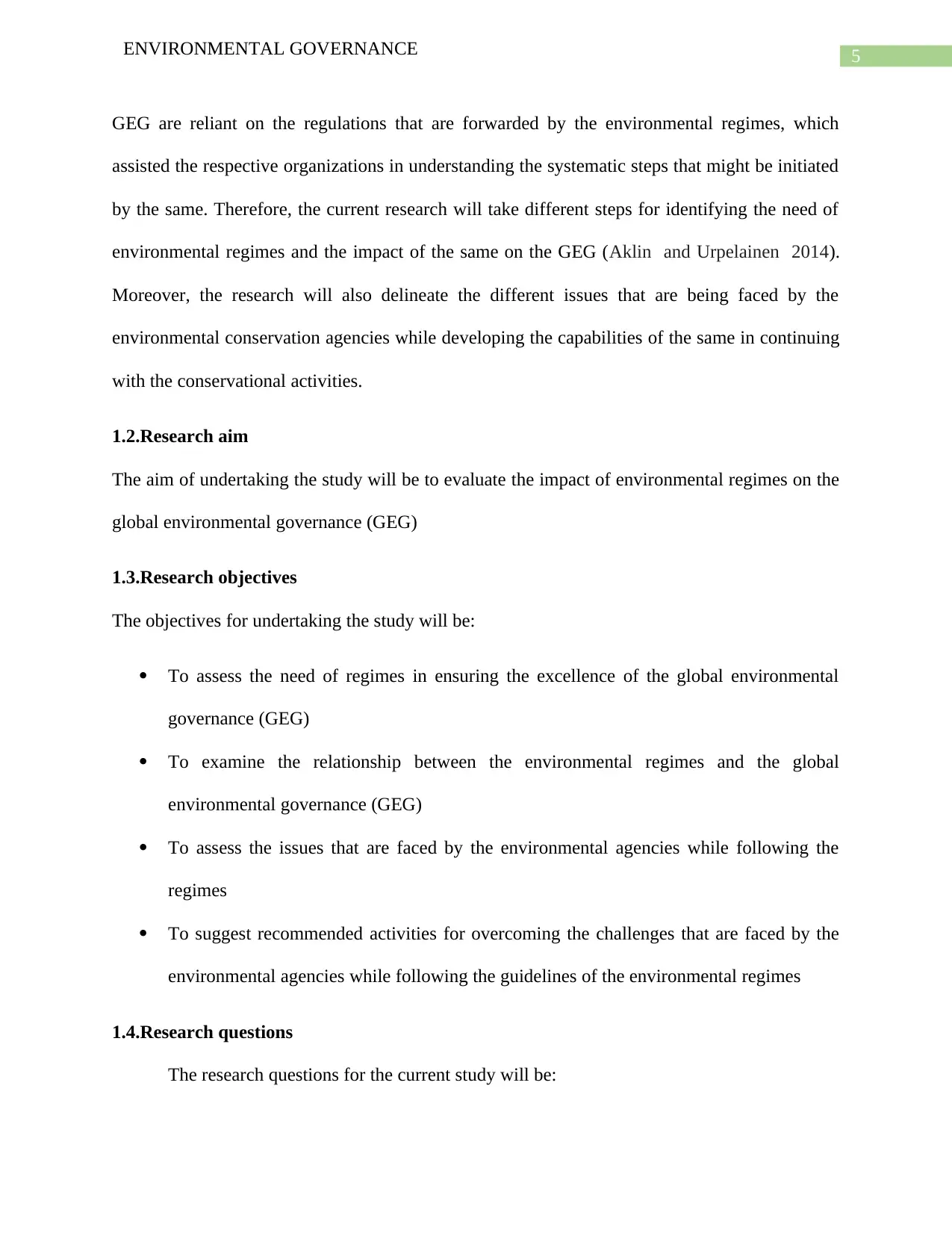
5ENVIRONMENTAL GOVERNANCE
GEG are reliant on the regulations that are forwarded by the environmental regimes, which
assisted the respective organizations in understanding the systematic steps that might be initiated
by the same. Therefore, the current research will take different steps for identifying the need of
environmental regimes and the impact of the same on the GEG (Aklin and Urpelainen 2014).
Moreover, the research will also delineate the different issues that are being faced by the
environmental conservation agencies while developing the capabilities of the same in continuing
with the conservational activities.
1.2.Research aim
The aim of undertaking the study will be to evaluate the impact of environmental regimes on the
global environmental governance (GEG)
1.3.Research objectives
The objectives for undertaking the study will be:
To assess the need of regimes in ensuring the excellence of the global environmental
governance (GEG)
To examine the relationship between the environmental regimes and the global
environmental governance (GEG)
To assess the issues that are faced by the environmental agencies while following the
regimes
To suggest recommended activities for overcoming the challenges that are faced by the
environmental agencies while following the guidelines of the environmental regimes
1.4.Research questions
The research questions for the current study will be:
GEG are reliant on the regulations that are forwarded by the environmental regimes, which
assisted the respective organizations in understanding the systematic steps that might be initiated
by the same. Therefore, the current research will take different steps for identifying the need of
environmental regimes and the impact of the same on the GEG (Aklin and Urpelainen 2014).
Moreover, the research will also delineate the different issues that are being faced by the
environmental conservation agencies while developing the capabilities of the same in continuing
with the conservational activities.
1.2.Research aim
The aim of undertaking the study will be to evaluate the impact of environmental regimes on the
global environmental governance (GEG)
1.3.Research objectives
The objectives for undertaking the study will be:
To assess the need of regimes in ensuring the excellence of the global environmental
governance (GEG)
To examine the relationship between the environmental regimes and the global
environmental governance (GEG)
To assess the issues that are faced by the environmental agencies while following the
regimes
To suggest recommended activities for overcoming the challenges that are faced by the
environmental agencies while following the guidelines of the environmental regimes
1.4.Research questions
The research questions for the current study will be:
⊘ This is a preview!⊘
Do you want full access?
Subscribe today to unlock all pages.

Trusted by 1+ million students worldwide
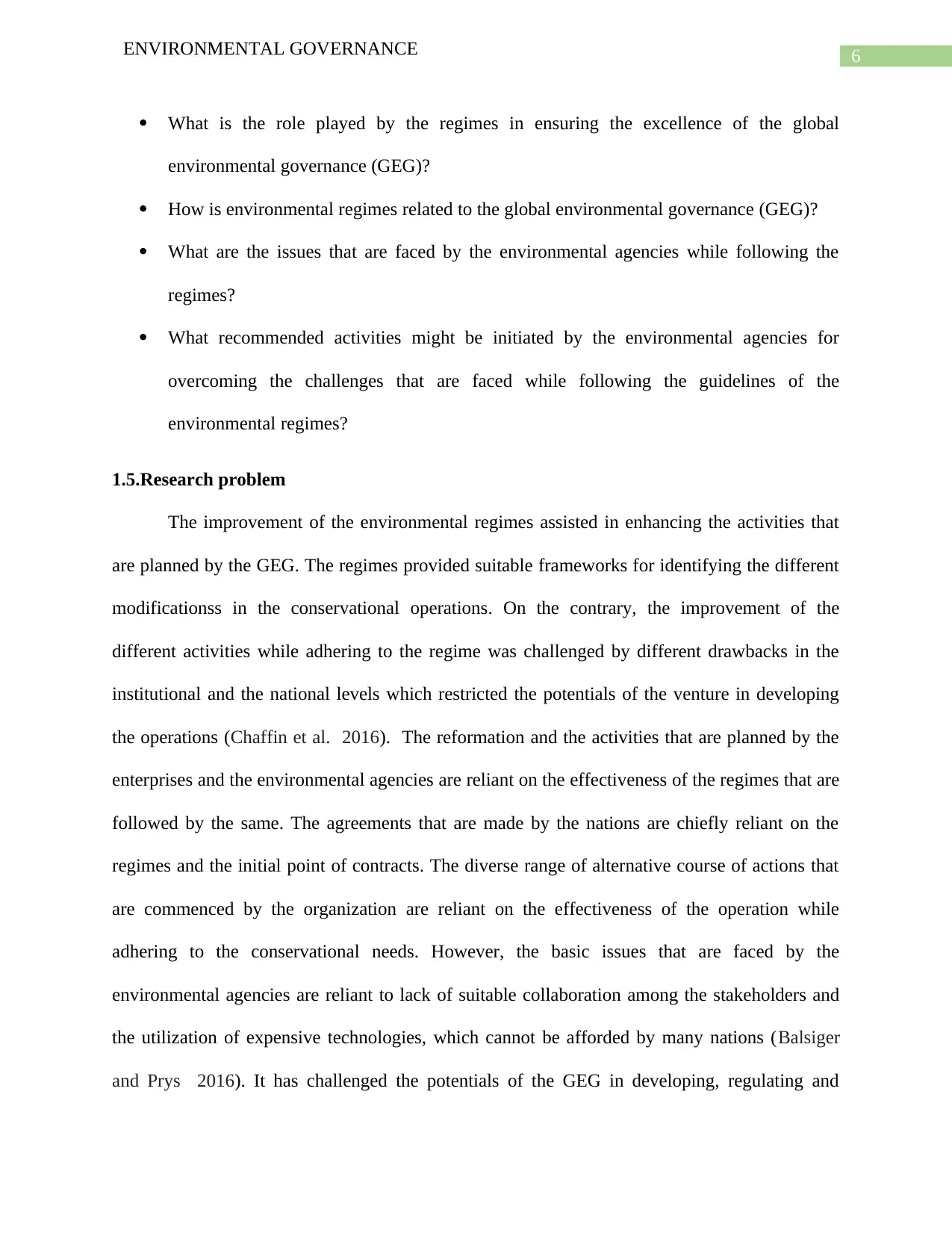
6ENVIRONMENTAL GOVERNANCE
What is the role played by the regimes in ensuring the excellence of the global
environmental governance (GEG)?
How is environmental regimes related to the global environmental governance (GEG)?
What are the issues that are faced by the environmental agencies while following the
regimes?
What recommended activities might be initiated by the environmental agencies for
overcoming the challenges that are faced while following the guidelines of the
environmental regimes?
1.5.Research problem
The improvement of the environmental regimes assisted in enhancing the activities that
are planned by the GEG. The regimes provided suitable frameworks for identifying the different
modificationss in the conservational operations. On the contrary, the improvement of the
different activities while adhering to the regime was challenged by different drawbacks in the
institutional and the national levels which restricted the potentials of the venture in developing
the operations (Chaffin et al. 2016). The reformation and the activities that are planned by the
enterprises and the environmental agencies are reliant on the effectiveness of the regimes that are
followed by the same. The agreements that are made by the nations are chiefly reliant on the
regimes and the initial point of contracts. The diverse range of alternative course of actions that
are commenced by the organization are reliant on the effectiveness of the operation while
adhering to the conservational needs. However, the basic issues that are faced by the
environmental agencies are reliant to lack of suitable collaboration among the stakeholders and
the utilization of expensive technologies, which cannot be afforded by many nations (Balsiger
and Prys 2016). It has challenged the potentials of the GEG in developing, regulating and
What is the role played by the regimes in ensuring the excellence of the global
environmental governance (GEG)?
How is environmental regimes related to the global environmental governance (GEG)?
What are the issues that are faced by the environmental agencies while following the
regimes?
What recommended activities might be initiated by the environmental agencies for
overcoming the challenges that are faced while following the guidelines of the
environmental regimes?
1.5.Research problem
The improvement of the environmental regimes assisted in enhancing the activities that
are planned by the GEG. The regimes provided suitable frameworks for identifying the different
modificationss in the conservational operations. On the contrary, the improvement of the
different activities while adhering to the regime was challenged by different drawbacks in the
institutional and the national levels which restricted the potentials of the venture in developing
the operations (Chaffin et al. 2016). The reformation and the activities that are planned by the
enterprises and the environmental agencies are reliant on the effectiveness of the regimes that are
followed by the same. The agreements that are made by the nations are chiefly reliant on the
regimes and the initial point of contracts. The diverse range of alternative course of actions that
are commenced by the organization are reliant on the effectiveness of the operation while
adhering to the conservational needs. However, the basic issues that are faced by the
environmental agencies are reliant to lack of suitable collaboration among the stakeholders and
the utilization of expensive technologies, which cannot be afforded by many nations (Balsiger
and Prys 2016). It has challenged the potentials of the GEG in developing, regulating and
Paraphrase This Document
Need a fresh take? Get an instant paraphrase of this document with our AI Paraphraser
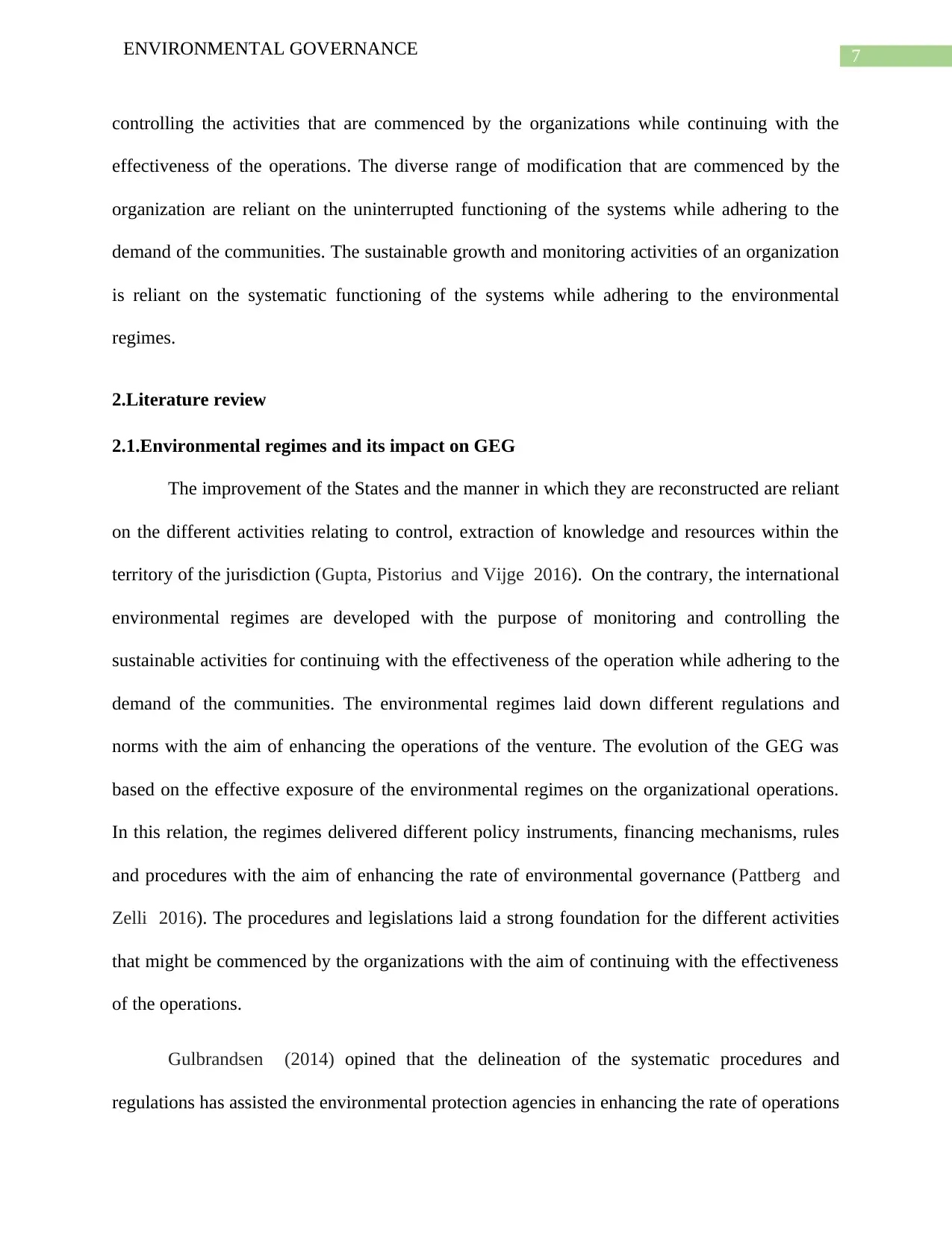
7ENVIRONMENTAL GOVERNANCE
controlling the activities that are commenced by the organizations while continuing with the
effectiveness of the operations. The diverse range of modification that are commenced by the
organization are reliant on the uninterrupted functioning of the systems while adhering to the
demand of the communities. The sustainable growth and monitoring activities of an organization
is reliant on the systematic functioning of the systems while adhering to the environmental
regimes.
2.Literature review
2.1.Environmental regimes and its impact on GEG
The improvement of the States and the manner in which they are reconstructed are reliant
on the different activities relating to control, extraction of knowledge and resources within the
territory of the jurisdiction (Gupta, Pistorius and Vijge 2016). On the contrary, the international
environmental regimes are developed with the purpose of monitoring and controlling the
sustainable activities for continuing with the effectiveness of the operation while adhering to the
demand of the communities. The environmental regimes laid down different regulations and
norms with the aim of enhancing the operations of the venture. The evolution of the GEG was
based on the effective exposure of the environmental regimes on the organizational operations.
In this relation, the regimes delivered different policy instruments, financing mechanisms, rules
and procedures with the aim of enhancing the rate of environmental governance (Pattberg and
Zelli 2016). The procedures and legislations laid a strong foundation for the different activities
that might be commenced by the organizations with the aim of continuing with the effectiveness
of the operations.
Gulbrandsen (2014) opined that the delineation of the systematic procedures and
regulations has assisted the environmental protection agencies in enhancing the rate of operations
controlling the activities that are commenced by the organizations while continuing with the
effectiveness of the operations. The diverse range of modification that are commenced by the
organization are reliant on the uninterrupted functioning of the systems while adhering to the
demand of the communities. The sustainable growth and monitoring activities of an organization
is reliant on the systematic functioning of the systems while adhering to the environmental
regimes.
2.Literature review
2.1.Environmental regimes and its impact on GEG
The improvement of the States and the manner in which they are reconstructed are reliant
on the different activities relating to control, extraction of knowledge and resources within the
territory of the jurisdiction (Gupta, Pistorius and Vijge 2016). On the contrary, the international
environmental regimes are developed with the purpose of monitoring and controlling the
sustainable activities for continuing with the effectiveness of the operation while adhering to the
demand of the communities. The environmental regimes laid down different regulations and
norms with the aim of enhancing the operations of the venture. The evolution of the GEG was
based on the effective exposure of the environmental regimes on the organizational operations.
In this relation, the regimes delivered different policy instruments, financing mechanisms, rules
and procedures with the aim of enhancing the rate of environmental governance (Pattberg and
Zelli 2016). The procedures and legislations laid a strong foundation for the different activities
that might be commenced by the organizations with the aim of continuing with the effectiveness
of the operations.
Gulbrandsen (2014) opined that the delineation of the systematic procedures and
regulations has assisted the environmental protection agencies in enhancing the rate of operations
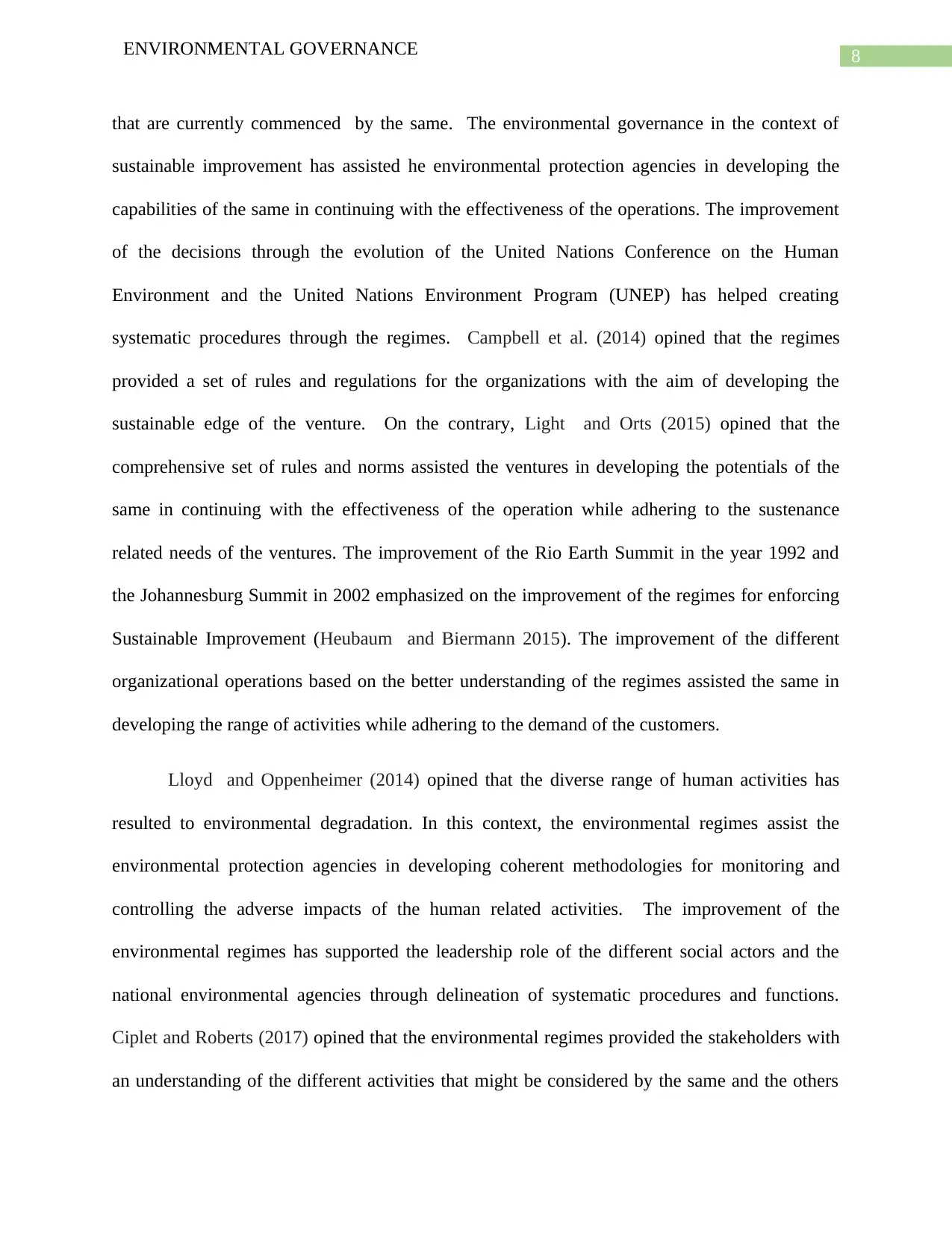
8ENVIRONMENTAL GOVERNANCE
that are currently commenced by the same. The environmental governance in the context of
sustainable improvement has assisted he environmental protection agencies in developing the
capabilities of the same in continuing with the effectiveness of the operations. The improvement
of the decisions through the evolution of the United Nations Conference on the Human
Environment and the United Nations Environment Program (UNEP) has helped creating
systematic procedures through the regimes. Campbell et al. (2014) opined that the regimes
provided a set of rules and regulations for the organizations with the aim of developing the
sustainable edge of the venture. On the contrary, Light and Orts (2015) opined that the
comprehensive set of rules and norms assisted the ventures in developing the potentials of the
same in continuing with the effectiveness of the operation while adhering to the sustenance
related needs of the ventures. The improvement of the Rio Earth Summit in the year 1992 and
the Johannesburg Summit in 2002 emphasized on the improvement of the regimes for enforcing
Sustainable Improvement (Heubaum and Biermann 2015). The improvement of the different
organizational operations based on the better understanding of the regimes assisted the same in
developing the range of activities while adhering to the demand of the customers.
Lloyd and Oppenheimer (2014) opined that the diverse range of human activities has
resulted to environmental degradation. In this context, the environmental regimes assist the
environmental protection agencies in developing coherent methodologies for monitoring and
controlling the adverse impacts of the human related activities. The improvement of the
environmental regimes has supported the leadership role of the different social actors and the
national environmental agencies through delineation of systematic procedures and functions.
Ciplet and Roberts (2017) opined that the environmental regimes provided the stakeholders with
an understanding of the different activities that might be considered by the same and the others
that are currently commenced by the same. The environmental governance in the context of
sustainable improvement has assisted he environmental protection agencies in developing the
capabilities of the same in continuing with the effectiveness of the operations. The improvement
of the decisions through the evolution of the United Nations Conference on the Human
Environment and the United Nations Environment Program (UNEP) has helped creating
systematic procedures through the regimes. Campbell et al. (2014) opined that the regimes
provided a set of rules and regulations for the organizations with the aim of developing the
sustainable edge of the venture. On the contrary, Light and Orts (2015) opined that the
comprehensive set of rules and norms assisted the ventures in developing the potentials of the
same in continuing with the effectiveness of the operation while adhering to the sustenance
related needs of the ventures. The improvement of the Rio Earth Summit in the year 1992 and
the Johannesburg Summit in 2002 emphasized on the improvement of the regimes for enforcing
Sustainable Improvement (Heubaum and Biermann 2015). The improvement of the different
organizational operations based on the better understanding of the regimes assisted the same in
developing the range of activities while adhering to the demand of the customers.
Lloyd and Oppenheimer (2014) opined that the diverse range of human activities has
resulted to environmental degradation. In this context, the environmental regimes assist the
environmental protection agencies in developing coherent methodologies for monitoring and
controlling the adverse impacts of the human related activities. The improvement of the
environmental regimes has supported the leadership role of the different social actors and the
national environmental agencies through delineation of systematic procedures and functions.
Ciplet and Roberts (2017) opined that the environmental regimes provided the stakeholders with
an understanding of the different activities that might be considered by the same and the others
⊘ This is a preview!⊘
Do you want full access?
Subscribe today to unlock all pages.

Trusted by 1+ million students worldwide
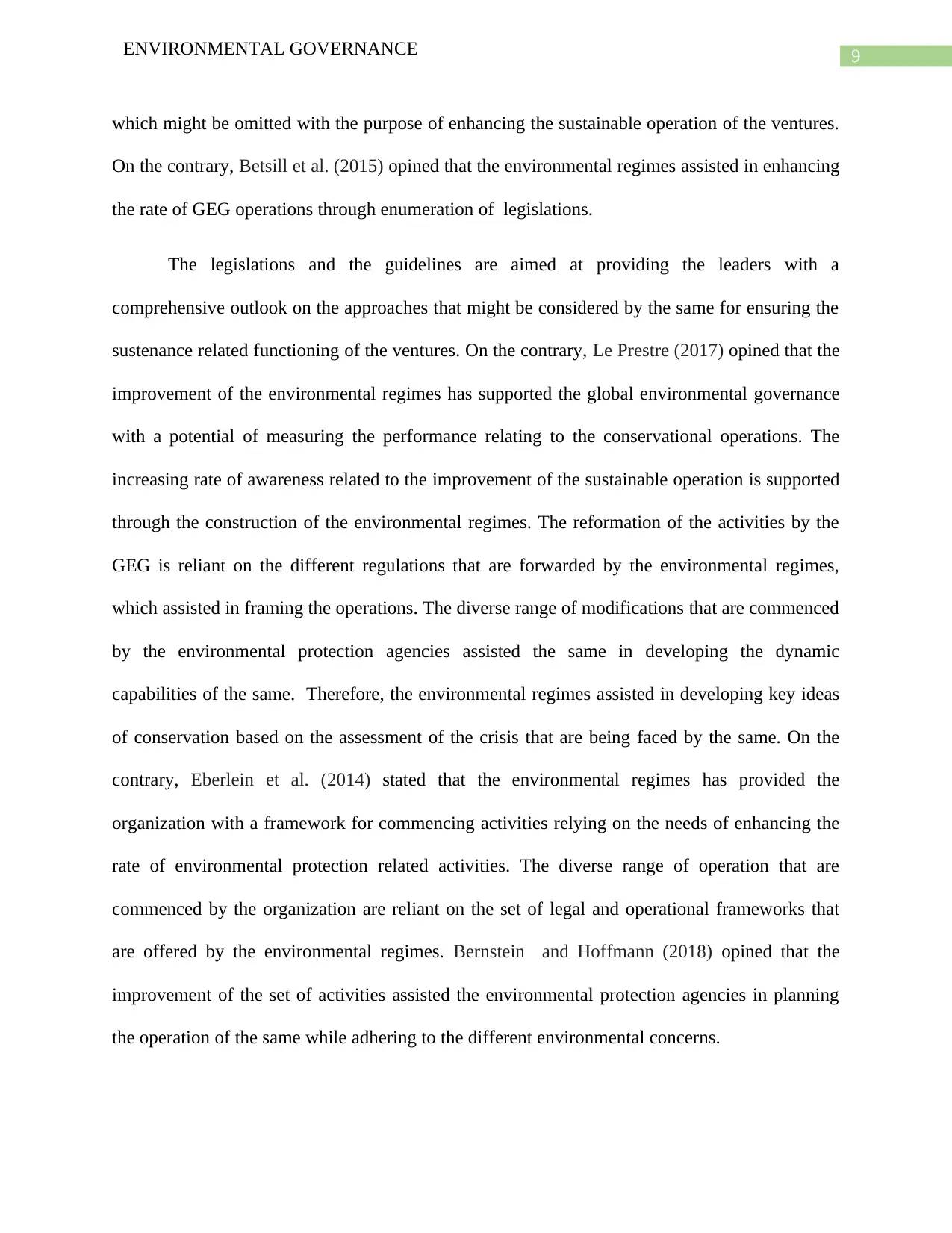
9ENVIRONMENTAL GOVERNANCE
which might be omitted with the purpose of enhancing the sustainable operation of the ventures.
On the contrary, Betsill et al. (2015) opined that the environmental regimes assisted in enhancing
the rate of GEG operations through enumeration of legislations.
The legislations and the guidelines are aimed at providing the leaders with a
comprehensive outlook on the approaches that might be considered by the same for ensuring the
sustenance related functioning of the ventures. On the contrary, Le Prestre (2017) opined that the
improvement of the environmental regimes has supported the global environmental governance
with a potential of measuring the performance relating to the conservational operations. The
increasing rate of awareness related to the improvement of the sustainable operation is supported
through the construction of the environmental regimes. The reformation of the activities by the
GEG is reliant on the different regulations that are forwarded by the environmental regimes,
which assisted in framing the operations. The diverse range of modifications that are commenced
by the environmental protection agencies assisted the same in developing the dynamic
capabilities of the same. Therefore, the environmental regimes assisted in developing key ideas
of conservation based on the assessment of the crisis that are being faced by the same. On the
contrary, Eberlein et al. (2014) stated that the environmental regimes has provided the
organization with a framework for commencing activities relying on the needs of enhancing the
rate of environmental protection related activities. The diverse range of operation that are
commenced by the organization are reliant on the set of legal and operational frameworks that
are offered by the environmental regimes. Bernstein and Hoffmann (2018) opined that the
improvement of the set of activities assisted the environmental protection agencies in planning
the operation of the same while adhering to the different environmental concerns.
which might be omitted with the purpose of enhancing the sustainable operation of the ventures.
On the contrary, Betsill et al. (2015) opined that the environmental regimes assisted in enhancing
the rate of GEG operations through enumeration of legislations.
The legislations and the guidelines are aimed at providing the leaders with a
comprehensive outlook on the approaches that might be considered by the same for ensuring the
sustenance related functioning of the ventures. On the contrary, Le Prestre (2017) opined that the
improvement of the environmental regimes has supported the global environmental governance
with a potential of measuring the performance relating to the conservational operations. The
increasing rate of awareness related to the improvement of the sustainable operation is supported
through the construction of the environmental regimes. The reformation of the activities by the
GEG is reliant on the different regulations that are forwarded by the environmental regimes,
which assisted in framing the operations. The diverse range of modifications that are commenced
by the environmental protection agencies assisted the same in developing the dynamic
capabilities of the same. Therefore, the environmental regimes assisted in developing key ideas
of conservation based on the assessment of the crisis that are being faced by the same. On the
contrary, Eberlein et al. (2014) stated that the environmental regimes has provided the
organization with a framework for commencing activities relying on the needs of enhancing the
rate of environmental protection related activities. The diverse range of operation that are
commenced by the organization are reliant on the set of legal and operational frameworks that
are offered by the environmental regimes. Bernstein and Hoffmann (2018) opined that the
improvement of the set of activities assisted the environmental protection agencies in planning
the operation of the same while adhering to the different environmental concerns.
Paraphrase This Document
Need a fresh take? Get an instant paraphrase of this document with our AI Paraphraser
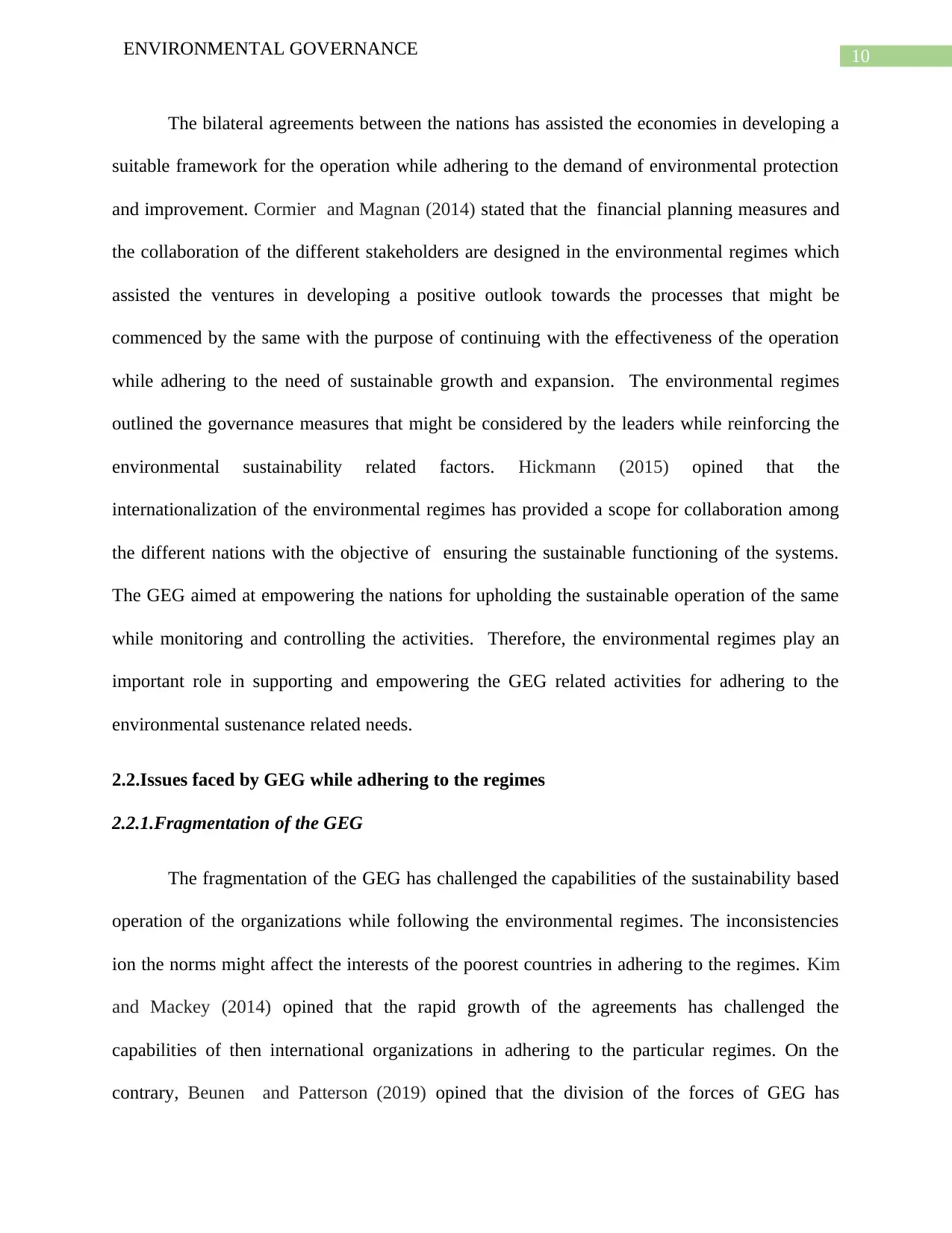
10ENVIRONMENTAL GOVERNANCE
The bilateral agreements between the nations has assisted the economies in developing a
suitable framework for the operation while adhering to the demand of environmental protection
and improvement. Cormier and Magnan (2014) stated that the financial planning measures and
the collaboration of the different stakeholders are designed in the environmental regimes which
assisted the ventures in developing a positive outlook towards the processes that might be
commenced by the same with the purpose of continuing with the effectiveness of the operation
while adhering to the need of sustainable growth and expansion. The environmental regimes
outlined the governance measures that might be considered by the leaders while reinforcing the
environmental sustainability related factors. Hickmann (2015) opined that the
internationalization of the environmental regimes has provided a scope for collaboration among
the different nations with the objective of ensuring the sustainable functioning of the systems.
The GEG aimed at empowering the nations for upholding the sustainable operation of the same
while monitoring and controlling the activities. Therefore, the environmental regimes play an
important role in supporting and empowering the GEG related activities for adhering to the
environmental sustenance related needs.
2.2.Issues faced by GEG while adhering to the regimes
2.2.1.Fragmentation of the GEG
The fragmentation of the GEG has challenged the capabilities of the sustainability based
operation of the organizations while following the environmental regimes. The inconsistencies
ion the norms might affect the interests of the poorest countries in adhering to the regimes. Kim
and Mackey (2014) opined that the rapid growth of the agreements has challenged the
capabilities of then international organizations in adhering to the particular regimes. On the
contrary, Beunen and Patterson (2019) opined that the division of the forces of GEG has
The bilateral agreements between the nations has assisted the economies in developing a
suitable framework for the operation while adhering to the demand of environmental protection
and improvement. Cormier and Magnan (2014) stated that the financial planning measures and
the collaboration of the different stakeholders are designed in the environmental regimes which
assisted the ventures in developing a positive outlook towards the processes that might be
commenced by the same with the purpose of continuing with the effectiveness of the operation
while adhering to the need of sustainable growth and expansion. The environmental regimes
outlined the governance measures that might be considered by the leaders while reinforcing the
environmental sustainability related factors. Hickmann (2015) opined that the
internationalization of the environmental regimes has provided a scope for collaboration among
the different nations with the objective of ensuring the sustainable functioning of the systems.
The GEG aimed at empowering the nations for upholding the sustainable operation of the same
while monitoring and controlling the activities. Therefore, the environmental regimes play an
important role in supporting and empowering the GEG related activities for adhering to the
environmental sustenance related needs.
2.2.Issues faced by GEG while adhering to the regimes
2.2.1.Fragmentation of the GEG
The fragmentation of the GEG has challenged the capabilities of the sustainability based
operation of the organizations while following the environmental regimes. The inconsistencies
ion the norms might affect the interests of the poorest countries in adhering to the regimes. Kim
and Mackey (2014) opined that the rapid growth of the agreements has challenged the
capabilities of then international organizations in adhering to the particular regimes. On the
contrary, Beunen and Patterson (2019) opined that the division of the forces of GEG has
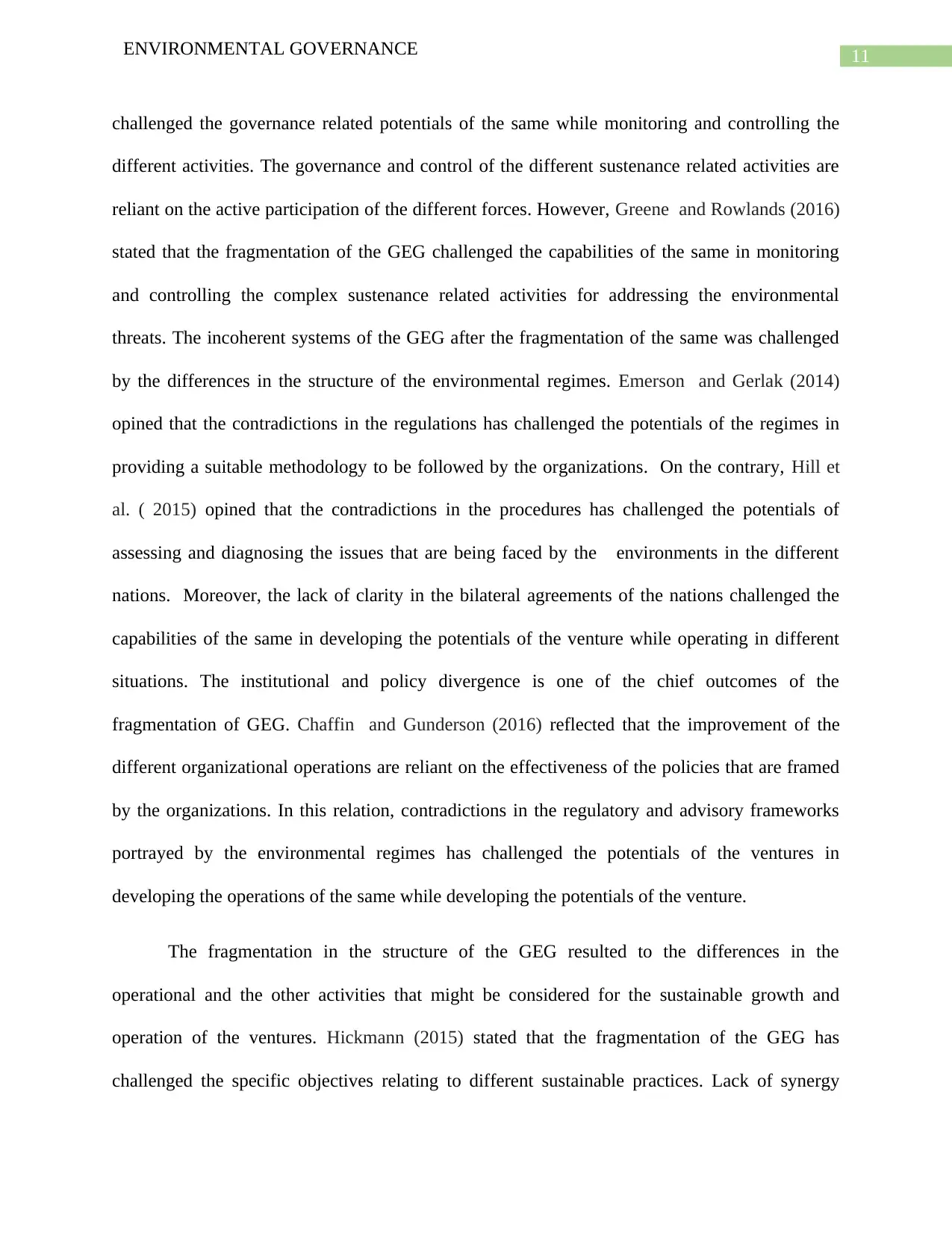
11ENVIRONMENTAL GOVERNANCE
challenged the governance related potentials of the same while monitoring and controlling the
different activities. The governance and control of the different sustenance related activities are
reliant on the active participation of the different forces. However, Greene and Rowlands (2016)
stated that the fragmentation of the GEG challenged the capabilities of the same in monitoring
and controlling the complex sustenance related activities for addressing the environmental
threats. The incoherent systems of the GEG after the fragmentation of the same was challenged
by the differences in the structure of the environmental regimes. Emerson and Gerlak (2014)
opined that the contradictions in the regulations has challenged the potentials of the regimes in
providing a suitable methodology to be followed by the organizations. On the contrary, Hill et
al. ( 2015) opined that the contradictions in the procedures has challenged the potentials of
assessing and diagnosing the issues that are being faced by the environments in the different
nations. Moreover, the lack of clarity in the bilateral agreements of the nations challenged the
capabilities of the same in developing the potentials of the venture while operating in different
situations. The institutional and policy divergence is one of the chief outcomes of the
fragmentation of GEG. Chaffin and Gunderson (2016) reflected that the improvement of the
different organizational operations are reliant on the effectiveness of the policies that are framed
by the organizations. In this relation, contradictions in the regulatory and advisory frameworks
portrayed by the environmental regimes has challenged the potentials of the ventures in
developing the operations of the same while developing the potentials of the venture.
The fragmentation in the structure of the GEG resulted to the differences in the
operational and the other activities that might be considered for the sustainable growth and
operation of the ventures. Hickmann (2015) stated that the fragmentation of the GEG has
challenged the specific objectives relating to different sustainable practices. Lack of synergy
challenged the governance related potentials of the same while monitoring and controlling the
different activities. The governance and control of the different sustenance related activities are
reliant on the active participation of the different forces. However, Greene and Rowlands (2016)
stated that the fragmentation of the GEG challenged the capabilities of the same in monitoring
and controlling the complex sustenance related activities for addressing the environmental
threats. The incoherent systems of the GEG after the fragmentation of the same was challenged
by the differences in the structure of the environmental regimes. Emerson and Gerlak (2014)
opined that the contradictions in the regulations has challenged the potentials of the regimes in
providing a suitable methodology to be followed by the organizations. On the contrary, Hill et
al. ( 2015) opined that the contradictions in the procedures has challenged the potentials of
assessing and diagnosing the issues that are being faced by the environments in the different
nations. Moreover, the lack of clarity in the bilateral agreements of the nations challenged the
capabilities of the same in developing the potentials of the venture while operating in different
situations. The institutional and policy divergence is one of the chief outcomes of the
fragmentation of GEG. Chaffin and Gunderson (2016) reflected that the improvement of the
different organizational operations are reliant on the effectiveness of the policies that are framed
by the organizations. In this relation, contradictions in the regulatory and advisory frameworks
portrayed by the environmental regimes has challenged the potentials of the ventures in
developing the operations of the same while developing the potentials of the venture.
The fragmentation in the structure of the GEG resulted to the differences in the
operational and the other activities that might be considered for the sustainable growth and
operation of the ventures. Hickmann (2015) stated that the fragmentation of the GEG has
challenged the specific objectives relating to different sustainable practices. Lack of synergy
⊘ This is a preview!⊘
Do you want full access?
Subscribe today to unlock all pages.

Trusted by 1+ million students worldwide
1 out of 29
Related Documents
Your All-in-One AI-Powered Toolkit for Academic Success.
+13062052269
info@desklib.com
Available 24*7 on WhatsApp / Email
![[object Object]](/_next/static/media/star-bottom.7253800d.svg)
Unlock your academic potential
Copyright © 2020–2025 A2Z Services. All Rights Reserved. Developed and managed by ZUCOL.




